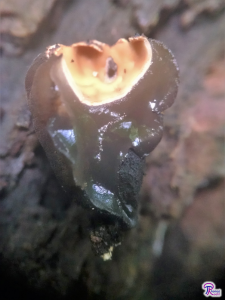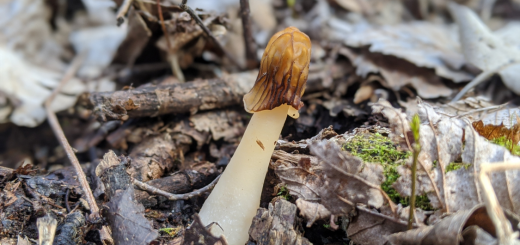#212: Galiella rufa, The Peanut Butter Cup Fungus

Galiella rufa is a distinctive cup fungus that features a light brown spore surface, dark brown lower surface, and gelatinous flesh. In North America it is difficult to confuse this species with any others.
Galiella rufa is easy to identify, which is unusual for a cup fungus. Its combination of light brown upper surface, dark brown lower surface, and gelatinous flesh make it instantly recognizable. Officially, the fungus’ common name is the “Hairy Rubber Cup.” This makes sense: its outer surface is covered with tiny hairs and the mushroom has a rubbery texture when you squeeze it. However, the name is kind of gross. I much prefer Michael Kuo’s idea of calling it the “Peanut Butter Cup Fungus,” after the disc-shaped chocolate and peanut butter snacks. The mushroom’s outer surface is chocolatey brown while the upper surface is peanut buttery brown. Additionally, both the snack and the fungus have a soft texture and tooth-like ridges around the upper surface. Unfortunately, the Peanut Butter Cup Fungus is inedible; the only peanut butter cups you should eat are the candies you buy from a store.1,2
Description
When G. rufa mushrooms first start to form, they are just wrinkly cylinders containing gelatinous flesh and covered with a blackish hairy outer layer. The spore-producing surface begins to form in a small cavity at the top end of the cylinder. As the spore-producing layer grows, the top of the cylinder inflates and the cavity expands. Eventually, the center of the top of the now more bulb-shaped fruiting body rips open to reveal the spore-producing layer.1–4
The upper surface of the mushroom (the inside of the cup) produces the spores and is smooth and orangish to reddish-brown to tan. When young, the upper surface is deeply cup-shaped. As the mushroom grows, however, the cup gets larger (up to 1-5cm across) and flatter and becomes more saucer-shaped when fully grown. Along the edges of the cup there are scattered patches of tooth-like tissue. These tufts are the remnants of the immature cup ripping open to reveal the spore surface.1–4
The lower surface (the outside of the cup) is dark brown to black and covered in small hairs. As the mushroom matures, the outer surface often forms wrinkles. This surface tapers down to the point of attachment, forming a poorly defined stalk. When present, the stalk grows 1-3cm tall. Inside, the grayish flesh is rubbery and gelatinous but tough.1–4

Galiella rufa grows on the forest floor and often appears terrestrial at first glance. However, it actually decomposes hardwood sticks and other debris.
Ecology
The Peanut Butter Cup Fungus is saprobic and spends its time on the forest floor decomposing hardwood sticks, logs, and other woody debris. G. rufa mushrooms fruit from spring through summer. In my area, they seem to be most plentiful just after morel season. G. rufa can be found east of the Rocky Mountains in North America, where it is a common mushroom.1–4
Similar species
While there are many species of cup fungi, no North American species are similar enough to G. rufa to be considered lookalikes. The most similar species is probably Wolfina aurantiopsis, which has a similar shape and a dark brown lower surface. However, that mushroom’s upper surface is yellow, its lower surface isn’t hairy, and its flesh has a corky texture.1,5

The ragged edge of the cup is produced when the top of the immature fruiting body rips open to reveal the spore-producing surface.
Taxonomy
G. rufa is one of only a handful of species in the genus Galiella, which was named for Mme Marcelle Le Gal, a French mycologist of the 1900’s.2,6,7 The fungus was moved from the genus Bulgaria into its own new genus Galiella in 1957 by mycologists John Axel Nannfeldt and Richard Paul Korf.1, 7–9 At the time, Korf had an ongoing fued with Le Gal over which scientific names were correct for the cup fungi and their relatives. Korf wanted to standardize names, which sometimes meant that names everyone used were suddenly found to be invalid. Le Gal thought this went too far and admonished Korf for adding unnecessary complexity to fungal taxonomy.6 As I see it, moving a single mushroom into a new genus named Galiella was a subtle way of needling his detractor across the Atlantic. The two later made up,6 so the genus now stands as a rare tribute to a female mycologist and to how personally involved science actually is.
The species name has a much less complicated history: “Rufa” means “reddish” and refers to the reddish-brown spore-producing surface.2
G. rufa belongs to the family Sarcosomataceae, which includes other large cup fungi like the Devil’s Urn, Urnula craterium (FFF#060).1,5,7 Higher up the taxonomic tree, that family belongs to the order Pezizales, which includes most other cup fungi as well as morels (FFF#033) and their relatives. All these fungi belong to the division Ascomycota (FFF#012), which produce sexual spores inside specialized cells called asci.
| Kingdom | Fungi |
| Division (Phylum) | Ascomycota |
| Subdivision (Subphylum) | Pezizomycotina |
| Class | Pezizomycetes |
| Subclass | Pezizomycetidae |
| Order | Pezizales |
| Family | Sarcosomataceae |
| Genus | Galiella |
| Species | Galiella rufa (Schwein.) Nannf. & Korf7 |
See Further:
http://www.mushroomexpert.com/galiella_rufa.html
http://www.messiah.edu/Oakes/fungi_on_wood/cup%20and%20saucer/species%20pages/Galiella%20rufa.htm
http://ncrfungi.uark.edu/species/55_galiellaRufa/galiellaRufa.html
Citations
- Kuo, M. Galiella rufa. MushroomExpert.Com (2012). Available at: http://www.mushroomexpert.com/galiella_rufa.html. (Accessed: 4th May 2018)
- Emberger, G. Galiella rufa. Fungi Growing on Wood (2008). Available at: http://www.messiah.edu/Oakes/fungi_on_wood/cup%20and%20saucer/species%20pages/Galiella%20rufa.htm. (Accessed: 4th May 2018)
- Labbé, R. Galiella rufa / Pézize rousse. Les champignons du Québec (2016). Available at: https://www.mycoquebec.org. (Accessed: 4th May 2018)
- Stephenson, S. L. Galiella rufa. Fungi of National Capital Region Parks (2011). Available at: http://ncrfungi.uark.edu/species/55_galiellaRufa/galiellaRufa.html. (Accessed: 4th May 2018)
- Beug, M. W., Bessette, A. & Bessette, A. R. Ascomycete fungi of North America: a mushroom reference guide. (2014).
- Pfister, D. H. et al. Richard Paul Korf (1925–2016). Mycologia 109, 529–534 (2017).
- Galiella rufa. Mycobank Available at: http://www.mycobank.org/Biolomics.aspx?Table=Mycobank&Rec=30501&Fields=All. (Accessed: 5th May 2018)
- John Axel Nannfeldt. Wikipedia (2016).
- Galiella. Wikipedia (2018).










![#011: Characteristics of Kingdom Fungi [Archived]](https://www.fungusfactfriday.com/wp-content/themes/hueman/assets/front/img/thumb-small-empty.png)



according to some easy to find links online the galliela rufa is considered edible in Malaysia